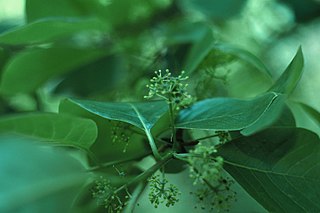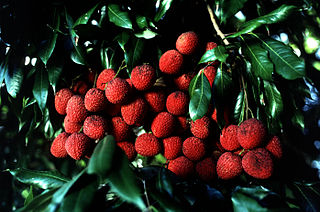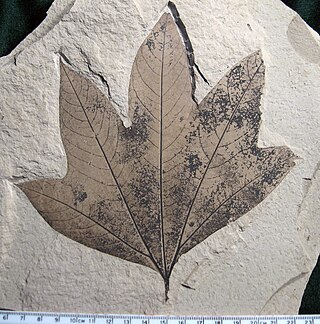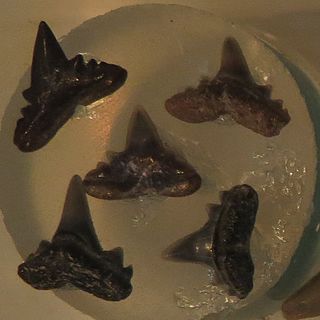
Tupelo, genus Nyssa, is a small genus of deciduous trees with alternate, simple leaves. It is sometimes included in the subfamily Nyssoideae of the dogwood family, Cornaceae, but is placed by other authorities in the family Nyssaceae. In the APG IV system, it is placed in Nyssaceae.

The Sapindaceae are a family of flowering plants in the order Sapindales known as the soapberry family. It contains 138 genera and 1,858 accepted species. Examples include horse chestnut, maples, ackee and lychee.

Archaeus is an extinct genus of marine jackfish from the Paleogene of Europe, where it inhabited the former Tethys Ocean. The oldest species, A. oblongus is from the early Ypresian epoch of Eocene Turkmenistan, and the last species, A. glarisianus and A. solus, are from the early to middle Rupelian, of the Oligocene lagerstatten of Canton Glarus, Switzerland and the Pshekha Formation of North Caucasus, Russia.

Acer is a genus of trees and shrubs commonly known as maples. The genus is placed in the soapberry family, Sapindaceae, along with lychee and horse chestnut. There are approximately 132 species, most of which are native to Asia, with a number also appearing in Europe, northern Africa, and North America. Only one species, Acer laurinum, extends to the Southern Hemisphere. The type species of the genus is the sycamore maple, Acer pseudoplatanus, the most common maple species in Europe. Maples usually have easily recognizable palmate leaves and distinctive winged fruits. The closest relatives of the maples are the horse chestnuts. Maple syrup is made from the sap of some maple species. It is one of the most common genera of trees in Asia. Many maple species are grown in gardens where they are valued for their autumn colour.

Florissantia is an extinct genus of flowering plants in the Malvaceae subfamily Sterculioideae known from western North America and far eastern Asia. Flower, fruit, and pollen compression fossils have been found in formations ranging from the Early Eocene through to the Early Oligocene periods. The type species is Florissantia speirii and three additional species are known, Florissantia ashwillii, Florissantia quilchenensis, and Florissantia sikhote-alinensis.

Dipteronia sinensis is a plant species in the genus Dipteronia, endemic to mainland China, and regarded in the soapberry family Sapindaceae sensu lato after Angiosperm Phylogeny Group and more recently ), or traditionally by several authors in Aceraceae, related to the maples.
Acer douglasense is an extinct maple species in the family Sapindaceae described from fossil leaves. The species is solely known from the Early Eocene sediments exposed in Katmai National Park and Preserve, Kodiak Island Borough, Alaska. It is the type species for the extinct section Douglasa.
Acer ashwilli is an extinct maple species in the family Sapindaceae described from a group of fossil leaves and samaras. The species is solely known from the Early Oligocene sediments exposed in central Oregon, USA. It is one of several extinct species belonging to the living section Ginnala.

The McAbee Fossil Beds is a Heritage Site that protects an Eocene Epoch fossil locality east of Cache Creek, British Columbia, Canada, just north of and visible from Provincial Highway 97 / the Trans-Canada Highway. The McAbee Fossil Beds, comprising 548.23 hectares, were officially designated a Provincial Heritage Site under British Columbia's Heritage Conservation Act on July 19, 2012. The site is part of an old lake bed which was deposited about 52 million years ago and is internationally recognised for the diversity of plant, insect, and fish fossils found there. Similar fossil beds in Eocene lake sediments, also known for their well preserved plant, insect and fish fossils, are found at Driftwood Canyon Provincial Park near Smithers in northern British Columbia, on the Horsefly River near Quesnel in central British Columbia, and at Republic in Washington, United States. The Princeton Chert fossil beds in southern British Columbia are also Eocene, but primarily preserve an aquatic plant community. A 2016 review of the early Eocene fossil sites from the interior of British Columbia discusses the history of paleobotanical research at McAbee, the Princeton Chert, Driftwood Canyon, and related Eocene fossil sites such as at Republic.

Eucommia is a genus of small trees now native to China, with a fossil record that shows a much wider distribution. The single living species, Eucommia ulmoides, is near threatened in the wild, but is widely cultivated in China for its bark, and is highly valued in herbology such as traditional Chinese medicine.

The Allenby formation is a sedimentary rock formation in British Columbia which was deposited during the Ypresian stage of the Early Eocene. It consists of conglomerates, sandstones with interbedded shales and coal. The shales contain an abundance of insect, fish and plant fossils known from 1877 and onward, while the Princeton Chert was first indented in the 1950's and is known from anatomically preserved plants.
This article records new taxa of fossil plants that are scheduled to be described during the year 2015, as well as other significant discoveries and events related to paleobotany that are scheduled to occur in the year 2015.

Macginitiea is an extinct genus in the family Platanaceae ranging from the Late Paleocene to Late Eocene of North America, known from the Clarno Formation of central Oregon. The genus is strictly used to describe leaves, but has been found in close association with other fossil platanoid organs, which collectively have been used for whole plant reconstructions. Macginitiea and its associated organs are important as together they comprise one of the most well-documented and ubiquitous fossil plants, particularly in the Paleogene of North America.

Ulmus okanaganensis is an extinct species of flowering plant in the family Ulmaceae related to the modern elms. The species is known from fossil leaves, flowers, and fruits found in the early Eocene deposits of northern Washington state, United States and similar aged formations in British Columbia, Canada.
This article records new taxa of fossil plants that are scheduled to be described during the year 2019, as well as other significant discoveries and events related to paleobotany that are scheduled to occur in the year 2019.

Abdounia is an extinct genus of requiem shark which lived during the Paleogene period. It is mainly known from isolated teeth. It is one of the earliest requiem sharks, and attained widespread success in North America, Europe, and Africa.
The paleoflora of the Eocene Okanagan Highlands includes all plant and fungi fossils preserved in the Eocene Okanagan Highlands Lagerstätten. The highlands are a series of Early Eocene geological formations which span an 1,000 km (620 mi) transect of British Columbia, Canada and Washington state, United States and are known for the diverse and detailed plant fossils which represent an upland temperate ecosystem immediately after the Paleocene-Eocene thermal maximum, and before the increased cooling of the middle and late Eocene to Oligocene. The fossiliferous deposits of the region were noted as early as 1873, with small amounts of systematic work happening in the 1880-90s on British Columbian sites, and 1920-30s for Washington sites. A returned focus and more detailed descriptive work on the Okanagan Highlands sites revived in the 1970's. The noted richness of agricultural plant families in Republic and Princeton floras resulted in the term "Eocene orchards" being used for the paleofloras.

Dipteronia brownii is an extinct species in the soapberry family (Sapindaceae) described in 2001. Fossils of D. brownii are known from stratigraphic formations in North America and Asia ranging in age between Paleocene to Early Oligocene.
The Paleobiota of the Klondike Mountain Formation comprises a diverse suite of Early Eocene plants and animals recovered from North Central Washington State. The formation outcrops in locations across the north western area of Ferry County, with major sites in Republic, north west of Curlew Lake, and on the Toroda Creek area. The formation is the southern most of the Eocene Okanagan Highlands, sharing much of the paleoflora and paleofauna with site across Central and southern British Columbia.















